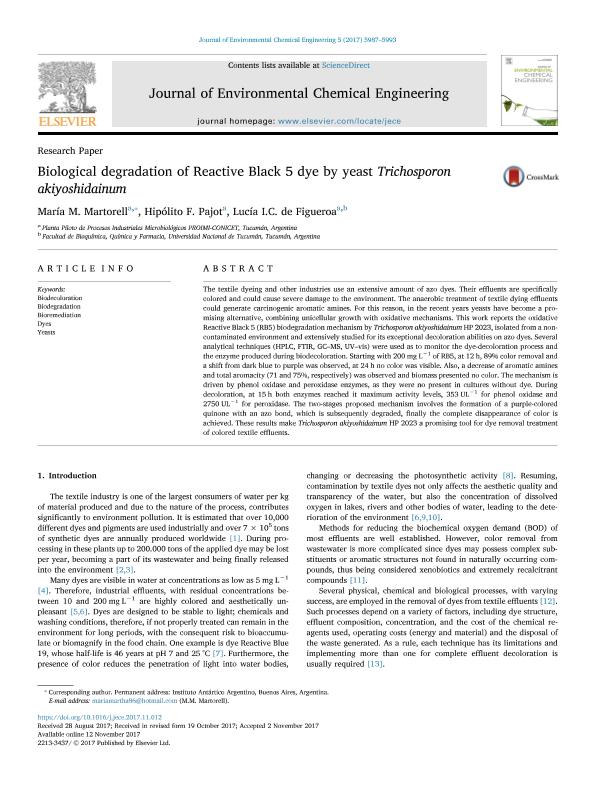Mostrar el registro sencillo del ítem
dc.contributor.author
Martorell, María Martha

dc.contributor.author
Pajot, Hipolito Fernando

dc.contributor.author
Castellanos, Lucia Ines

dc.date.available
2018-11-01T15:40:26Z
dc.date.issued
2017-12
dc.identifier.citation
Martorell, María Martha; Pajot, Hipolito Fernando; Castellanos, Lucia Ines; Biological degradation of Reactive Black 5 dye by yeast Trichosporon akiyoshidainum; Elsevier; Journal of Environmental Chemical Engineering; 5; 6; 12-2017; 5987-5993
dc.identifier.issn
2213-3437
dc.identifier.uri
http://hdl.handle.net/11336/63438
dc.description.abstract
The textile dyeing and other industries use an extensive amount of azo dyes. Their effluents are specifically colored and could cause severe damage to the environment. The anaerobic treatment of textile dying effluents could generate carcinogenic aromatic amines. For this reason, in the recent years yeasts have become a promising alternative, combining unicellular growth with oxidative mechanisms. This work reports the oxidative Reactive Black 5 (RB5) biodegradation mechanism by Trichosporon akiyoshidainum HP 2023, isolated from a non-contaminated environment and extensively studied for its exceptional decoloration abilities on azo dyes. Several analytical techniques (HPLC, FTIR, GC–MS, UV–vis) were used as to monitor the dye-decoloration process and the enzyme produced during biodecoloration. Starting with 200 mg L−1 of RB5, at 12 h, 89% color removal and a shift from dark blue to purple was observed, at 24 h no color was visible. Also, a decrease of aromatic amines and total aromacity (71 and 75%, respectively) was observed and biomass presented no color. The mechanism is driven by phenol oxidase and peroxidase enzymes, as they were no present in cultures without dye. During decoloration, at 15 h both enzymes reached it maximum activity levels, 353 UL−1 for phenol oxidase and 2750 UL−1 for peroxidase. The two-stages proposed mechanism involves the formation of a purple-colored quinone with an azo bond, which is subsequently degraded, finally the complete disappearance of color is achieved. These results make Trichosporon akiyoshidainum HP 2023 a promising tool for dye removal treatment of colored textile effluents.
dc.format
application/pdf
dc.language.iso
eng
dc.publisher
Elsevier

dc.rights
info:eu-repo/semantics/openAccess
dc.rights.uri
https://creativecommons.org/licenses/by-nc-nd/2.5/ar/
dc.subject
Biodecoloration
dc.subject
Biodegradation
dc.subject
Bioremediation
dc.subject
Dyes
dc.subject
Yeasts
dc.subject.classification
Bioremediación, Diagnóstico Biotecnológico en Gestión Medioambiental

dc.subject.classification
Biotecnología del Medio Ambiente

dc.subject.classification
INGENIERÍAS Y TECNOLOGÍAS

dc.title
Biological degradation of Reactive Black 5 dye by yeast Trichosporon akiyoshidainum
dc.type
info:eu-repo/semantics/article
dc.type
info:ar-repo/semantics/artículo
dc.type
info:eu-repo/semantics/publishedVersion
dc.date.updated
2018-10-24T13:15:39Z
dc.journal.volume
5
dc.journal.number
6
dc.journal.pagination
5987-5993
dc.journal.pais
Países Bajos

dc.journal.ciudad
Amsterdam
dc.description.fil
Fil: Martorell, María Martha. Ministerio de Relaciones Exteriores, Comercio Interno y Culto. Dirección Nacional del Antártico. Instituto Antártico Argentino; Argentina. Consejo Nacional de Investigaciones Científicas y Técnicas. Centro Científico Tecnológico Conicet - Tucumán. Planta Piloto de Procesos Industriales Microbiológicos; Argentina
dc.description.fil
Fil: Pajot, Hipolito Fernando. Consejo Nacional de Investigaciones Científicas y Técnicas. Centro Científico Tecnológico Conicet - Tucumán. Planta Piloto de Procesos Industriales Microbiológicos; Argentina
dc.description.fil
Fil: Castellanos, Lucia Ines. Consejo Nacional de Investigaciones Científicas y Técnicas. Centro Científico Tecnológico Conicet - Tucumán. Planta Piloto de Procesos Industriales Microbiológicos; Argentina
dc.journal.title
Journal of Environmental Chemical Engineering
dc.relation.alternativeid
info:eu-repo/semantics/altIdentifier/doi/http://dx.doi.org/10.1016/j.jece.2017.11.012
dc.relation.alternativeid
info:eu-repo/semantics/altIdentifier/url/https://www.sciencedirect.com/science/article/pii/S2213343717305705
Archivos asociados
